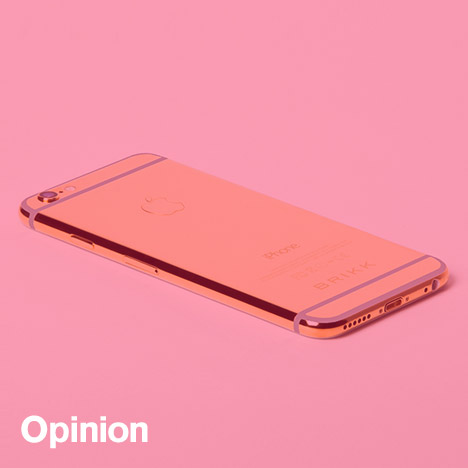
"Even obsolescence is worthy of incredible expense"
Opinion: mobile products have a short lifespan, but Apple has invested heavily in turning them into desirable design objects. For some "luxury" customers that just isn't enough, finds Alex Wiltshire.
Would you pay $5,000 for a phone? What about $8,000? Handcrafted and utterly distinctive, it won't be the same phone that's in the pockets of millions of others. But would you invest all that money into something that will be approaching obsolescence in a couple of years? Something that you might drop down your loo tomorrow, or simply find to have stopped working?
Apple is pretty much the undisputed leader in the design of mass-produced technology. The rest of the tech world struggles to challenge the popularity of the assiduously curved anodised aluminium and planes of glass used in its MacBooks, iPhones, iPads and – inevitably – the upcoming Apple Watch. In Apple's world, everyone, from a teenager to a CEO, can enjoy the same material perfection for the same price: a sugar-free celebration of what Warhol loved about America.
And yet there is Feld & Volk. This Russian self-described atelier strips away the machined finishes of iPhones and iPads and replaces them with the extravagance of gold and wood, mother of pearl and carbon. And it charges a lot of money for them.
In the Pure Gold model, the iPhone 5s is treated to a custom backing with a backlit Apple logo and a sapphire glass backing (an almost magically tough material that Apple itself only started using with the iPhone 6) screen-printed with a green-gold pattern. The metal surround and buttons are replaced with 18-carat gold and engraved details are added, including Feld & Volk's logo. Alternatively, you can get the same re-spec but themed with the national colours of the United Arab Emirates, complete with lit coat of arms, or one where only the buttons are gold and the back features a red/gold flower pattern.
In the Wood edition the back is made from the tightly knotted grain of Karelian birch (as used for one of Fabergé’s most famous eggs), hand-treated to make it more resistant to temperature and water, and machined with tolerances for error of no more than half a millimetre. Only 77 have been produced. The Pure Gold? $8,990. The Wood model is $4,799.
Feld & Volk is by no means the only company which is modifying Apple designs. Los Angeles-based Brikk sells the Lux range, which plates the cases of the iPhone 5s and 6, iPads, HTC One and Galaxy Gear and Note 3 in 24-carat gold, pink gold or platinum. Geneva-based Golden Dreams modifies iPhones with alligator leather backs. But the craft of Moscow-based Feld & Volk, recently on sale at the Paris fashion shop Colette and soon to have its own Moscow shop, puts it at the top of this field.
In its products, Apple's values of necessity and restraint are exchanged for those of luxury. "We are balancing on the thin line between luxury and practicality," said co-founder Alexander Volkov, explaining that his designs for phones have to take into account their need to take calls and photos, and whatever else. But when it comes to luxury, the materials evidently come first.
When the iPhone 6 launched, Feld & Volk, which currently counts 25 permanent staff, disassembled it to see which components could be exchanged for something more expensive, and that bit less practical. Feld & Volk phones are heavier by around 12 grams and back-lit models will drain the battery slightly faster, though the company claims that the radio signal isn't affected by the changes in the fabric of the phones.
Not that the kind of people who'd spend so much money on a phone probably care too much. Such modifications reseat the whole purpose of the phone. The everyday workhorse, identical to all others, becomes an individualised status symbol, especially if you have Feld & Volk make you a custom model. Volkov says that his clients range from "men of weight" in business to corporations looking for branded gifts to give to staff, trying to make a personal statement through an object that would otherwise be identical in the pockets of a film star, president and bum.
There's something bizarre about such ostentation being attached to something as transitory as a phone, whether superseded by next year's model, passed over by the latest operating system upgrade, or simply dropped. Isn't luxury supposed to carry a sense of timelessness? Luxury phone maker Vertu tries to soften the bite by adding concierge features to the package, but Feld & Volk's phone stands with nothing other than its year's warranty.
It's tempting to see Feld & Volk's work as arising from similar impulses that gave Russian Tsars such a soft spot for Fabergé eggs: naked proclamations of wealth. But a Fabergé egg will last centuries. Perhaps the sheer impermanence of such an investment makes it an even headier statement of opulence?
And now Apple appears to be turning down a similar path, with rumours that the gold version of the Apple Watch will cost over £3000. We don't yet know to what extent its innards will be subject to obsolescence, given that they will rely on iPhones to process the data they display, but it's hard to imagine one lasting like a Rolex Oyster. Perhaps it's all a sign of a maturation of such ubiquitous pieces of technology, that they've taken up such a central role in life that even obsolescence is worthy of incredible expense.
Alex Wiltshire is a video game consultant, with clients including London's V&A Museum. He was editor of Edge Magazine until 2013 and has written for a wide range of publications including Icon, The New Statesman, PC gamer, Eurogamer, Design Week and Architects Journal.